- Established 1982 -HOME: www.hiltonpond.org
THIS WEEK at HILTON POND Subscribe for free to our award-winning nature newsletter (Back to Preceding Week; on to Next Week) |
AN IRRUPTION--AND SUDDEN DEPARTURE--OF PINE SISKINS For quite a few years folks in Canada have produced a "Winter Finch Forecast," alerting us further south of what to expect in the way of sometimes irruptive species such as Purple Finches, Pine Siskins, American Goldfinches, Red-breasted Nuthatches, crossbills, redpolls, or those crowd-pleasing but ever-elusive Evening Grosbeaks. The forecast is based on observations by field naturalists who fan out across Canadian provinces to check how well trees and other plants have produced seeds, fruits, and nuts. In poor mast years, the species above--all of which are facultative migrants that don't "have to" depart every fall like obligate migrant Neotropical warblers--wander southward in much larger numbers than usual. Such irruptions are gleefully anticipated by enthusiasts in the Carolina Piedmont and beyond who, like us at Hilton Pond Center, stock up on black sunflower and thistle seed in the hope of luring uncommon winter species to backyard feeders.
All text, maps, charts & photos © Hilton Pond Center The cold months of 2020-21 were predicted to be a "Finch Winter" in the continental U.S. as seed-bearing plants throughout Canada were indeed under-producing potential winter food. Thus, feeders were well-stocked and ready at Hilton Pond by mid-October. We were hopeful we'd capture lots of Purple Finches (PUFI) and Pine Siskins (PISI, above)--especially because both have been encountered at distant locales after being banded at the Center. We should point out our earliest-ever autumn PUFI came on 19 October 1991 and our earliest PISI on 30 October 1983, but those were unusual dates. Often we have not seen winter finches until December or January. Nonetheless, on the afternoon of 17 October this year we were delighted when a little flock of siskins fed on sunflower seeds (above) and even more so as five entered a sunflower seed trap in rapid succession. We now had a new, much-earlier arrival date for this species. (NOTE: The first Purple Finch was observed on 1 November, with our initial PUFI banding three days later.) All text, maps, charts & photos © Hilton Pond Center Click on chart above to open a larger, clearer version in a new browser window In some ways it's not accurate to say irruptive finch species are "uncommon" at Hilton Pond Center; better to call them "irregular" and maybe even "unpredictable." After all, our "winter finches" might not show up every year, but they do make up four of our top five species (see chart above) and a huge fraction of bandings at the Center. Back on 26 March 2019 those four comprised a high of 49.94%--almost exactly half--of all birds banded locally from 1982 through that date. (NOTE: As of 15 November this year, lots of 2020 songbirds, doves, woodpeckers, and Ruby-throated Hummingbirds had slimmed that fraction a little to 49.31%.)
All text, maps, charts & photos © Hilton Pond Center It's also a little misleading these days to refer to House Finches (HOFI) and/or American Goldfinches (AMGO) as either "irruptive" or "winter finches"--which deserves some explanation. Historically we seldom observed or captured AMGO during breeding months, although they commonly appeared in winter with flocks of Purple Finches. However, in the past dozen years or so, we banded more and more summer goldfinches--including recent fledglings, females with active brood patches, and brightly colored males in full breeding plumage (above). All these are evidence American Goldfinches now breed regularly at or very near Hilton Pond, although it appears many of our winter AMGO are indeed migrants from up north.
All text, maps, charts & photos © Hilton Pond Center House Finches (adult male, above) are an even more interesting situation. Although they are a native North American species, HOFI originally bred out west and didn't occur in the eastern U.S. until 1940. That year and the next a few dozen illegally imported HOFI were released by pet shop owners on Long Island NY. The species thrived as those first eastern HOFI apparently migrated south each winter and returned north. However, House Finches also began expanding their breeding range about 25 miles per year south and west of New York, eventually reaching the Charlotte NC area in the late 1970s. (In 1984 we found the first known HOFI nest in York County at Rock Hill SC, just over the border from Charlotte.) All text, maps, charts & photos © Hilton Pond Center Click on chart above to open a larger, clearer version in a new browser window By the time we started banding at Hilton Pond Center in 1982, House Finches were numerous in winter. We handled substantial numbers in the cold months (see chart above), including our amazing and still-standing record of 976 in the winter of 1983-84. As far as we could tell, the vast majority those HOFI departed for the northland in spring--as suggested by banded individuals encountered later in Ontario, New York, and Massachusetts. (NOTE: We've also recaptured wintering House Finches at Hilton Pond that had been banded during the breeding season in New York and Pennsylvania.) Sometime in the late 1980s or early 1990s all this seemed to change and instead of migrating long distances each fall and spring House Finches became more and more sedentary, with northern breeders staying north and our local breeders never departing. As the chart above shows, our local population appears to have settled into a rhythm, with big winter invasions by HOFI no longer occurring.
All text, maps, charts & photos © Hilton Pond Center But what about this year's Pine Siskins and Purple Finches (after-second-year male, above)? As noted, these two species are a different story in that they come south only during bad seed winters in Canada--which is what we have in 2020. After those first few PISI arrived "early" on 17 October, numbers grew dramatically during the next several days:
All text, maps, charts & photos © Hilton Pond Center Those 12 days in October yielded a whopping 207 Pine Siskins (above)--what seemed to be the first wave of the incursion. (And we'll mention again that we'd never had a siskin show up at the Center prior to 30 October.) You might know that eBird, the on-line bird observation database operated by Cornell Laboratory of Ornithology, repeatedly red-flagged our Pine Siskin sightings, apparently because they were (quotes are ours) "arriving too early in the winter," "appearing out of normal geographical range," and/or "occurring in numbers that were too high." Then came November, when siskin numbers were somewhat lower:
The first half of November shows relatively big days for PISI banded on the 4th, 6th, 11th and 12th, but all of a sudden on 13 November and thereafter there were no more Pine Siskins! After reaching a total of 301 PISI banded at Hilton Pond over a 30-day span, the siskins just disappeared! Pine Siskins are known to be a nomadic species that wanders from one feeding locale to another, appearing suddenly in big flocks one day and being gone soon thereafter. Even so, it's difficult to understand why or where they might have gone after partaking of our sunflower seed banquet for nearly a month. The feeders are still full, so they certainly didn’t run out of food.
All text, maps, charts & photos © Hilton Pond Center (By the way, after the first Purple Finch of the year appeared at the Center's feeders in late October, we banded just 10 individuals from 4-15 November before they, too, disappeared. All were brown birds, as above, which we classified as unknown age and unknown sex; that's because only adult male PUFI at least two years old are raspberry-colored. By comparison, American Goldfinches weren't quite as elusive in November, with 16 banded during the first half of the month before they also pulled a disappearing act.)
All text, maps, charts & photos © Hilton Pond Center So for us the first main question is: 1) What caused our multitude of Pine Siskins--AND the Purple Finches and American Goldfinches--to leave Hilton Pond Center? (Resident House Finches remain in small numbers.) Are any or all three species so nomadic they're just inclined to drop in one day for snacks and depart the next? Did warm weather in early November prompt them to temporarily go back north a little? Did abundant, well-stocked bird feeders in the South spread out the winter finch population? And how about those late fall hurricanes possibly creating unusual November weather patterns this year? Has a stealthy, bird-hunting Sharp-shinned Hawk shown up at the Center, causing its favored prey to abandon our feeding station? Do early arriving finches replenish their fat reserves at feeders and then disperse to dine on berries and Sweetgum seeds still abundant in the Southeast during late fall? Or is it something else entirely? We may never know the answer to these kinds of questions, but another main query may eventually have an answer: 2) Specifically, where did all these October and early November birds go? The primary reason for banding winter finches while they were at Hilton Pond this fall was to try to solve this second big question. Putting a numbered band on a bird's leg offers opportunity to follow its movements, so perhaps one or more of those birds we caught will show up elsewhere to be recaptured by another bander, or--more likely (and more sadly)--to be found after hitting someone's picture window. In either instance, banded birds can be reported to the federal Bird Banding Lab at REPORTBAND.GOV in the hope we can better understand the comings and goings of irruptive winter finches that wander south when food sources are scarce up north. We just wonder this year if those irruptive winter finches are ever coming back . . . . HURRICANE ETA: All text, maps, charts & photos © Hilton Pond Center And now, a couple of weather notes. Thanks to Hurricane Eta, York County SC and Hilton Pond Center were under a flash flood warning on 12 November 2020. Rains started that day at 6 a.m. by 11:45 a.m. we already had 5.28" in the digital rain gauge! Light drizzle continued after that, bringing the day's total to 5.30". Hilton Pier--the thin horizontal line at left in our photo above--was nearly submerged, a situation unprecedented in the 37 years since we built it. (That's the U.S.S. Hilton at right, a floating dock we can untether and use to move about the pond to check Wood Duck boxes, etc.) Hilton Dam held fast but was overflowing mightily at the spillway. (We hope not too many fishes went over the top.) Since Hilton Pond Center is a research facility on private property, we have the advantage of establishing permanent lanes where we can erect mist nets to capture birds for banding studies. At many other sites, researchers must deploy nets each morning and take them down completely at night--a time-consuming and tiring operation. At the Center we leave our nets in place, simply rolling them closed at dusk and opening them quickly the following dawn. When weather is cold (below 40°), rainy, or especially windy we never unfurl. Most of the time this works to our advantage and we are able to put in more active net-hours per day. However, in this disruptive year of 2020 having nets closed but in position worked against us on more than one occasion. Easter Monday strong winds toppled a huge and ancient Southern Red Oak tree that destroyed four nets and obliterated their net lanes and lots of habitat. A few months later a powerful-straight-line wind hurled large tree limbs into two nets, tearing their mesh and making them unusable. Shortly after that, another gale pushed over two Red Maple snags that fell directly on a seventh mist net. So guess what happened after Hurricane Eta remnants moved through the Carolina Piedmont?
All text, maps, charts & photos © Hilton Pond Center Yeah, you guessed it. All that 5.30" of rain saturated a 12-foot-long dead Pecan limb that got too heavy and snapped off. It fell, of course, directly onto one of our most productive mist nets (above), snapping its trammel strings and bending two metal net poles at odd angles. Another net bites the dust! That makes EIGHT mist nets lost so far just this year due to storms. Remarkably, in our preceding 38 years of research at Hilton Pond, only SIX nets had been lost to weather or--in one case--when a half-dozen deer chased by dogs tore through two of the nets. (The deer survived, but both nets were useless thereafter.) Needless to say, replacing all these recent net losses at nearly $150 per whack (for American-made mist net, two poles, and anchors) isn't exactly what our annual budget called for! The good news is none of those eight nets were brand-new. Many were several years old and nearing their usable lifespan, and several had been on more than one Operation RubyThroat hummingbird expedition to the Neotropics. Properly cared for, high-quality nets may be expensive, but they last a long time. Even so, those eight losses will have to be replaced, and we only have two more nets in reserve at the moment. We can't prove a cause-and-effect relationship, but evidence is strong that something about 2020 has brought bad juju to mist nets at Hilton Pond Center! In the case of flood warnings we're just glad the old farmhouse is on a little knoll. All text, maps, charts & photos © Hilton Pond Center Photoshop image post-processing uses DeNoise AI, Sharpen AI , and other Topaz Lab tools
Checks also can be sent to Hilton Pond Center at: All contributions are tax-deductible on your Don't forget to scroll down for Nature Notes & Photos, |
|---|
|
"This Week at Hilton Pond" is written and photographed by Dr. Bill Hilton Jr., executive director of Hilton Pond Center for Piedmont Natural History
|
|
|
Please refer "This Week at Hilton Pond" to others by clicking on this button: |
|

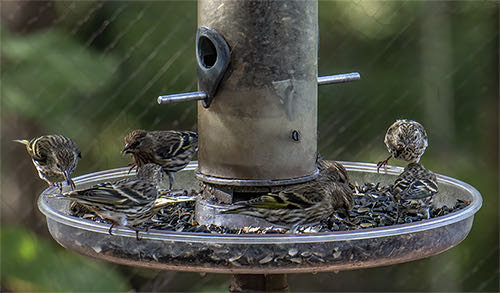
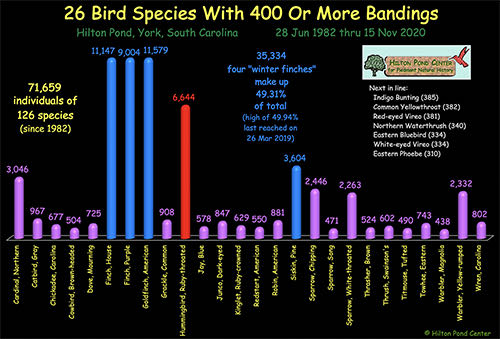
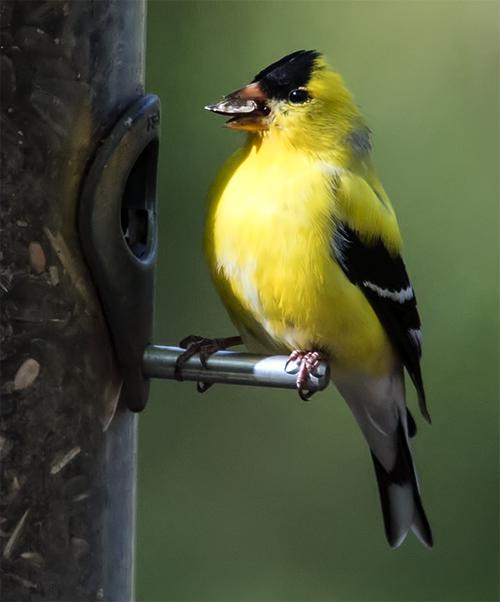
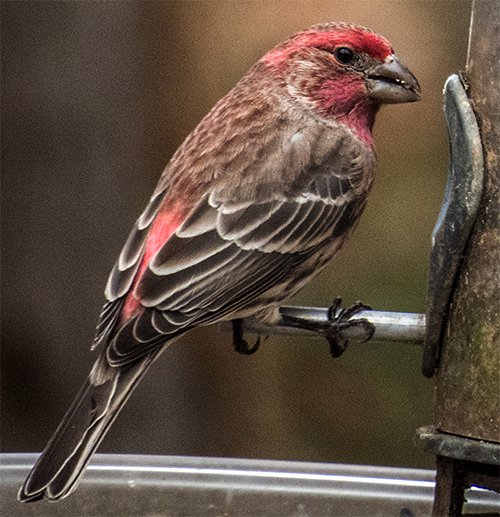

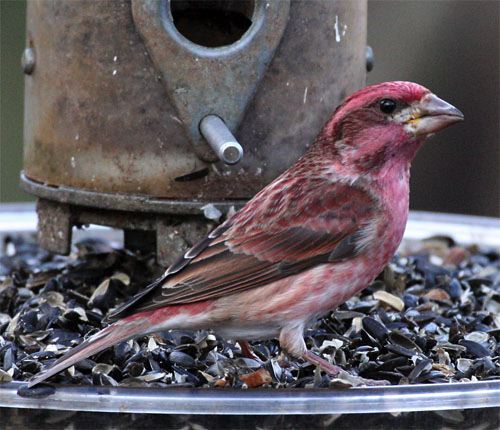
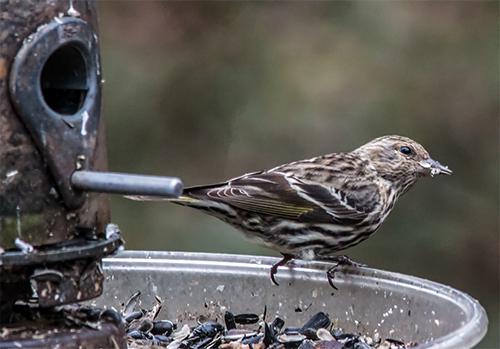
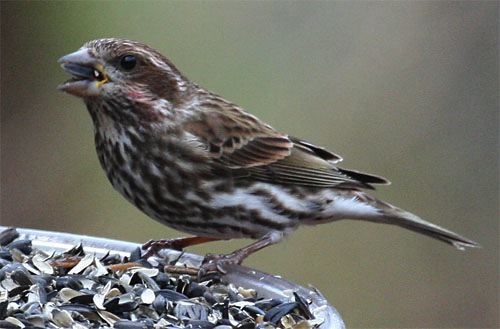
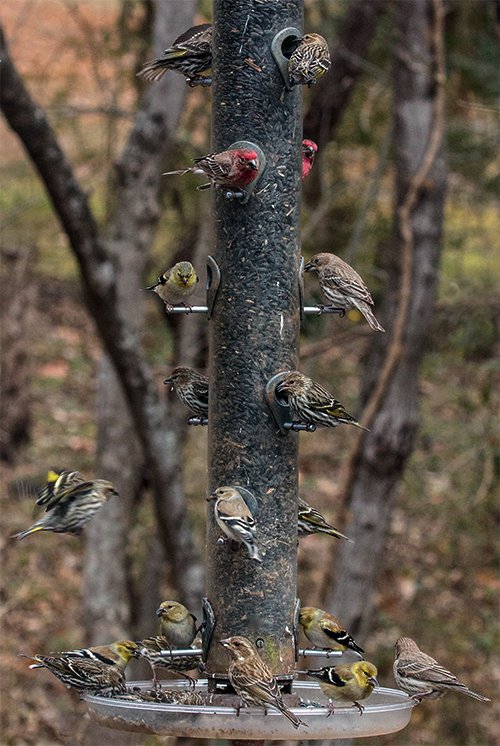
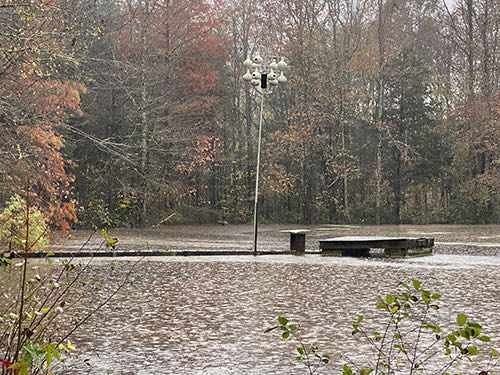
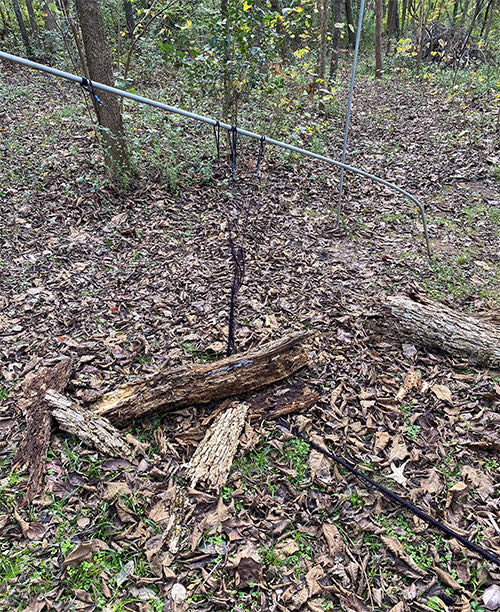










 Oct 15 to Mar 15:
Oct 15 to Mar 15: